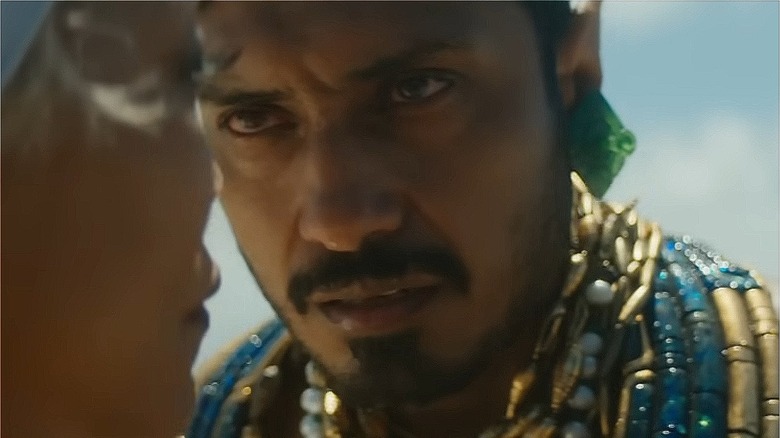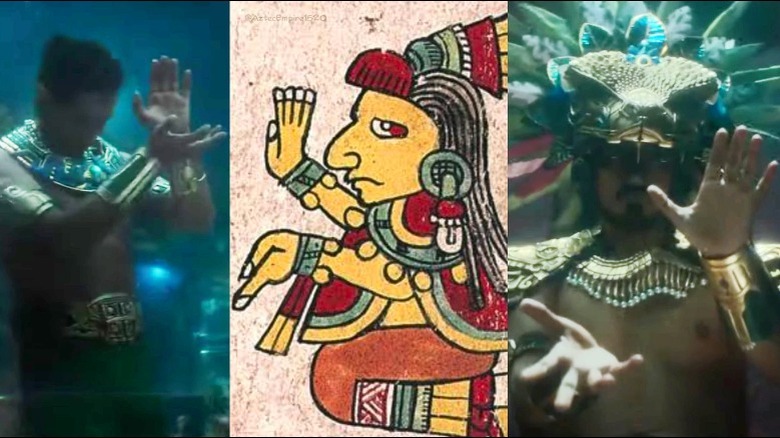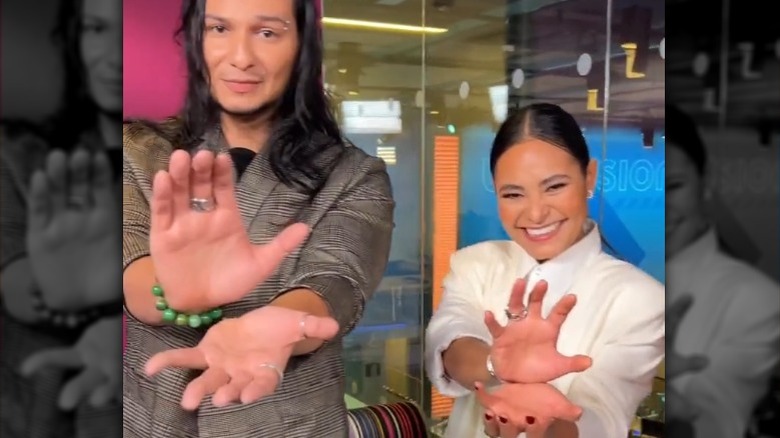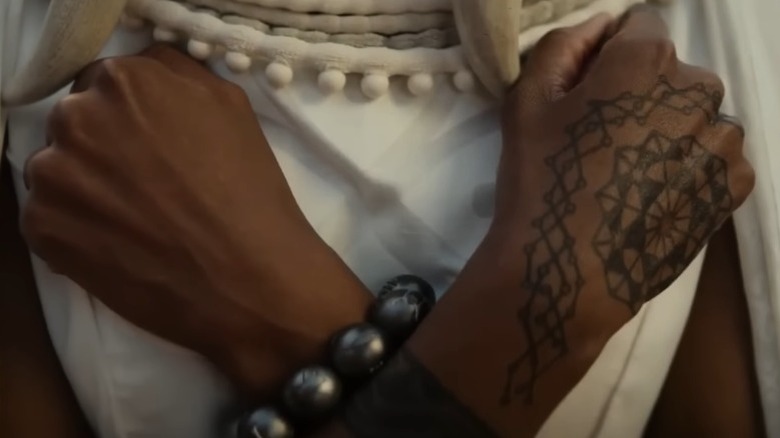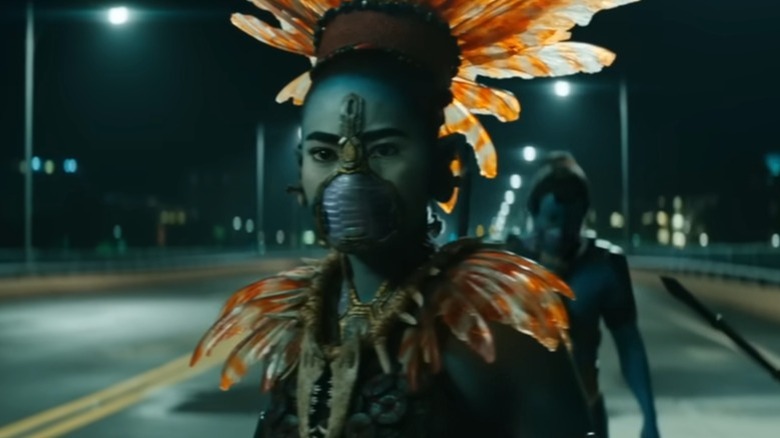Wakanda Forever's Talokan Salute Is Rooted In Real Mesoamerican History
When "Black Panther" came out in 2018, the "Wakanda Forever" salute became so popular that it left a lasting imprint on the cultural zeitgeist. Even Trevor Noah of "The Daily Show" told the star of that movie, Chadwick Boseman, that "everywhere you go now, for the rest of your life, you will be greeted like this," crossing his forearms arms over his chest with his fists balled. Since then, fans of that movie — especially those of African and African-American descent — have leaned into that gesture and adopted it as a form of cultural representation. And now, in the newly released sequel "Black Panther: Wakanda Forever," the Talokan salute looks like it might have a similar effect on Latiné culture.
But the Talokan salute didn't just come out of nowhere. And it wasn't made up by some screenwriter in a dark basement trying to think of a snappy gesture that would catch on with the kids. The battle cry you see on the silver screen actually has origins in real-world history. What's even more incredible is that if not for the efforts of a passionate group of actors, it never would have made it into the movie in the first place.
It's a gesture that dates back thousands of years
It's hard to pinpoint the exact origin of the hand gesture that is used in the movie for the Talokan salute. This is because the artwork that inspired it came from different Mesoamerican tribes, which were interconnected, traded frequently, and (more or less) peacefully coexisted. But many of the stone statues which depict this hand gesture are found among Mayan ruins. The Corn deity sculpture from Copan, for example, can be seen performing the gesture and was found among some of the most well-preserved Mayan ruins in Honduras. That statue, in particular, is estimated to be over 1,300 years old.
The gesture also appears frequently in codices created by the Mixtecs. They were neighbors to the Mayans for many years until the Spanish conquistadors started pillaging the North American continent. The one depicted above is from the Codex Nuttall. Archaeologists believe that the codex was made during the 1300s, which makes it around 600 years younger than its Mayan predecessor. Given how the iconic gesture existed among the Mesoamerican tribes for at least half a millennium (if not longer), the cultural significance is unquestionably profound.
The Latiné actors came up with it — it wasn't originally in the script
The actors have not been shy when it comes to talking about the gesture and how it came to be such an important part of Talokan culture in the movie. During an interview with Cinema Blend, Alex Livinalli (who plays Attuma in the movie) admitted that the salute "was not part of the original script. "It was a conscientious thing that we were like, the [Wakandans] have 'Wakanda Forever,' and it's so powerful, and it means so much. And we're very similar to the Wakandans, you know, we need something! So after a conversation with a language instructor, we came up with 'Talokan rises!', which is...Lik'ik Talokan!"
That was the origin of the chant, but the gesture itself — in addition to its origins in Mesoamerican art — reflects aspects of both ancient and modern-day Latiné culture. This Univision interview, featuring Livinalli as well as Tenoch Huerta Mejía (Namor) and Mabel Cadena (Namora), shows the three actors demonstrating the salute and explaining (in Spanish) what it means for the Talokan people and them personally. The ancestral meaning has more to do with worshiping the sun and/or opening things up, but Huerta also added that "if all you use it for is to say 'hey what's up?', that's fine, too."
The Wakanda Forever salute has its own historical and cultural roots, too
One of the reasons the Wakanda forever salute has had such a profound cultural impact is that it didn't come about by accident. According to Inverse, the salute has roots in ancient West African culture and modern-day American Sign Language. The gesture can mean either "love" or "hug" in ASL, and director Ryan Coogler likely incorporated it because of his wife and her experience with the ASL community.
While the meaning of the crossed arms has faded over time, some believe that it was a symbol of royalty in ancient West African cultures. Others think it's a symbol of death due to how Osiris, the god of death in Egyptian mythology, was often depicted. Given the fact that Wakandans have a strong, dynastic, and proud warrior culture, having them greet each other with a gesture that simultaneously means love, royalty, and death seems very fitting.
Social media is loving the lore (and begging for more)
Now that the Latiné actors have followed in the footsteps of the first movie and come up with a proud, powerful salute to reflect Talokan culture — a fictional culture that was heavily inspired by real-world Mesoamerican history — taking a deep dive and learning more about this lore has been a real treat for fans. @ImperiusWrecked is already demanding that Marvel release a 400-page companion lore book. And while they may be joking, we don't doubt that it would make Marvel a nice little chunk of change. In addition to that humble request, there are dozens of Twitter threads with fans happily geeking out about the origins of the Talokan salute.
Interestingly enough, whether on accident or on purpose, the salute is reflective of modern-day cultural influences as well. @fucthewhat astutely pointed out that it looks a lot like the Kamehameha, a power move from the Japanese anime "Dragon Ball Z" — a cartoon which, although Japanese in origin, is extremely popular in Latin American culture today. Other Twitter users like @AlwayzHustlin38 and @mrubio248 have pointed out that the Talokan salute looks a lot like the Hadouken move from the popular "Street Fighter" video game series as well as the superhero franchise "The Power Rangers." Both the games and the show feature powerful warriors, so it's easy to understand how it could get co-opted to represent the warrior culture of the Talokan people in the movie.
